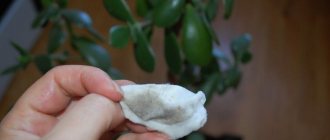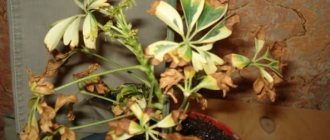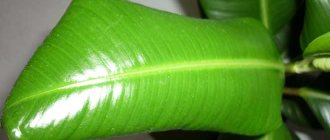Many gardeners love ficuses not only for their external beauty, but also for their unpretentiousness, because these plants do not need to be watered, fed or replanted often. But, despite this, certain difficulties with growing ficuses still arise. Most often this concerns leaf falling.
In this article, we will give the main reasons that may explain why the ficus sheds its leaves, and what measures should be taken to ensure that the plant remains green.
- Air temperature
Features of growing ficus
When growing ficus, you need to become familiar with the needs of the plant. The optimal room temperature is determined depending on the type. Usually it should be within +18...+20°C, however, there are varieties for which +10°C is optimal. Comfortable air humidity is 50–70%.
Lighting should be bright and diffused. The ficus tree does not like either direct light or darkness, but is shade-tolerant. Moderate watering is preferable; both the soil should not dry out or be excessively waterlogged. Young specimens are transplanted once a year. Plants older than 4 years are replanted less frequently - once every 2-3 years.
Also, we must not forget about fertilizers. The exact frequency of fertilizing depends on the variety, but most often it is necessary to fertilize in the spring-summer period every 1–1.5 weeks with preparations for ornamental foliage plants, for example, with “Rainbow” or “Ideal” products.
Why ficus leaves fall: reasons and what to do
Ficus sheds its leaves for two reasons. This can be either a natural process or a consequence of improper plant maintenance. That is why, before deciding how to save a ficus, you need to determine the exact cause of its condition.
Did you know? The largest ficus banyan tree grows in India. Its age is more than 200 years, the diameter of the main trunk is 12 m. The crown of this tree has grown to 12,000 m² and is supported by collateral and aerial roots that have grown to the size of individual trunks.
Natural process
The normal life rhythm of a ficus includes the stage of shedding its leaves. This is a natural process that occurs in autumn or early winter. Thanks to the loss of leaves, the plant successfully enters a dormant state.
In the future, the leaf plates must grow again. Most often, the ficus first loses the lower parts of the crown. At first they acquire a yellowish color, then they begin to dry out and fall off.
Improper care
Very often, the reason for the loss of foliage by a ficus is the wrong approach to its maintenance. Microclimate disturbances, improper watering and replanting negatively affect the condition of the plant, which is why the leaves begin to fall.
Violation of containment conditions
The microclimate plays a very important role when growing ficus. Cold and drafts are extremely harmful to the plant. For most species, if the temperature drops below +16°C, the foliage is highly likely to fall.
Important! It is highly advisable to avoid sudden changes in temperature, humidity or light levels. The plant does not like change, including a change of location.
You should also avoid exposure to high temperatures. Although ficus is classified as a heat-loving species, at temperatures above +30°C the plant withers, the leaf blades change color to yellowish and have difficulty remaining on the stem. However, it is necessary to pay attention to the specific species being grown and the optimal indicators for it.
An important factor is the level of moisture in the air. Leaves often fall off due to excessive dryness. This often happens in the summer, when it is quite hot outside and the air in the room also warms up above normal.
However, even in winter there is a risk of increased air dryness due to the operation of radiators or heaters. The owner needs to monitor the humidity and, if necessary, adjust its levels using special air humidifiers.
We must not forget about lighting. Species characterized by a variegated pattern on the leaf blades do not tolerate light shading. Varieties with green leaves can grow in partial shade.
Also find out what to do if ficus benjamina loses its leaves.
However, too strong a shadow has a detrimental effect on the condition of any ficus. As a result of being placed in a dark space, symptoms may occur in the form of weakening of the crown, lethargy, withered foliage and, as a result, its falling.
Improper watering
Watering the ficus should be moderate. The soil should not be allowed to dry out too much. A similar situation can happen due to poor or infrequent soil moisture. As a result, the crown dries out, turns yellow and does not stay on the trunk for a long time.
A similar effect occurs if watering, on the contrary, is too abundant. You should not allow water to stagnate in the soil, as the process of root rot begins. It can be identified by its unpleasant putrid odor. If the situation is not corrected in time by adjusting the watering, gradual damage to the trunk begins. The leaves acquire a dark color and fall off the stem.
Read more about the features of watering ficus at home.
Incorrect transplant
Since ficus trees do not tolerate any changes well, a reaction in the form of dropping leaves may occur during transplantation. It is for this reason that the plant cannot be replanted often.
The maximum frequency of changing the pot and soil is 2 times a year. Often gardeners, knowing about the possible reaction of the plant, resort to only a superficial change of soil instead of a full transplant.
Pesticides
When dealing with pests, pesticides become the first resort for many home plant owners. Chemical-based substances are also used to prevent the development of various diseases.
The effect of intensive treatment of ficus with such drugs is often negative. Pesticides are dangerous because they create a strong load on the plant, as a result of which the leaves do not stay on the trunk, weaken and fly off.
Important! When treating with pesticides and other drugs, safety rules should be followed. It is advisable to use rubber gloves and eye protection in the form of glasses.
Pests and diseases
A common cause of leaf falling is the development of various diseases. Fungal infections are dangerous for ficus. They appear most often due to excessive moisture in the substrate.
In addition to crown shedding, the fungus causes discoloration and spotting on different parts of the plant. As a therapeutic measure, you need to get rid of the affected areas and treat with a fungicide, for example, the drug "Carbendazim".
No less dangerous are pests, among which you can most often find:
- aphids;
- spider mite;
- scale insect.
Insects suck the juices from the leaf blades, as a result of which they weaken and do not adhere to the trunk.
The first aid in this case will be manual collection and destruction of pests using a soap solution. Next, the plant should be treated with a systemic insecticide, for example, Actellik or Inta-vir. We also recommend that you find out what to do if your ficus leaves turn yellow and curl.
Reason #1. Abrupt change in conditions
Some ficus plants are simply very capricious in terms of changing growing conditions.
Of course, each type of ficus has its own requirements for living conditions, but there are also “record holders for capriciousness.” The main “picky” plant in this regard is the already mentioned Ficus Benjamin, which reacts with massive leaf fall to literally any changes.
Ficus growers even joke about this: “If you bought a Benjamin ficus, then you don’t need to ask whether it will shed leaves in your apartment, you need to ask exactly when and how quickly it will do it.”
The light from the window became brighter in the spring, or you opened the window wide, turned the radiators on or off (changing the air humidity), in the fall it became cooler in the apartment, the child carelessly touched the plant while watering, or you moved the pot to a nearby window sill for convenience - and here is a tree, which just pleased you with its lush openwork crown of variegated leaves, stands almost bald.
The same demanding ficuses include ficus sacred, ficus rough, ficus equifolia, ficus Palmer, ficus microcarpa.
In most cases, having become a little angry at the careless owners and being left alone, such a plant will soon grow into foliage again. But not always.
So if you are the owner of an apartment where the windows are constantly open and there is a draft, children and animals run around, touching the plants, you often forget to water indoor flowers on time or regularly rearrange them around the room - maybe you just need to replace the “whims” with more unpretentious ones and resistant to change representatives of the clan? For example, rubber ficus, lyre-shaped ficus, willow ficus.
Why does ficus shed leaves in winter?
Shedding leaves at the beginning of winter can be caused by various reasons.
The main ones are:
- natural transition to a state of dormancy, provided that the crown has fallen at the beginning of the season;
- reduced daylight hours and poor lighting;
- changes in humidity and temperature due to the operation of heating devices in the room.
It is also necessary to remember about other reasons such as diseases, pests or improper care.
How to prevent leaves from falling
To prevent the ficus from shedding its crown, you need to take the following preventive measures:
- maintaining the correct microclimate (temperature, humidity and lighting);
- ensuring a stable location and conditions;
- moderate treatment with chemicals;
- replanting no more than once a year for young (up to 4 years) and once every 2–3 years for older ficuses;
- water the soil in moderation, avoiding waterlogging or drying out of the substrate;
- timely treatment of diseases and pests.
Did you know? The fig tree from which the figs are harvested is a type of ficus.
Violation of soil acidity
Ficus needs soil that is neutral in acidity, with a pH level of 6.0-7. Most purchased soils have approximately the same indicators - just check them on the packaging. However, the acidity of the soil may change over time, for example, the irrigation water contained many alkalis. You can check the acidity level using litmus papers, which can be purchased at any gardening store.
Useful care tips
In order for the ficus to please its owners for a long time, you should not only adhere to the basic rules, but also learn the intricacies of caring for it:
- The ficus tree is quite undemanding. The main thing is to disturb it as little as possible and maintain stable conditions. In summer, however, it can be taken out onto the terrace or balcony.
- If there are problems with lighting , special lamps can be purchased in flower grower stores.
- In addition to the frequency of watering, water characteristics are important for ficus. It must be soft and no colder than room temperature. Also, the plant is sprayed with warm water when it is extremely dry and the leaves are washed to remove dust and dirt.
The fall of the crown of a ficus is a very annoying problem. However, it can be avoided by adhering to the basic rules of plant care and promptly resorting to treatment of diseases and adjusting the approach to cultivation.
Lack of light, hypothermia and dryness
Dropping leaves is a typical reaction of ficuses to excessive distance from the window into the interior, especially if they were previously standing on the windowsill. And the more interesting the variety is in color, the more sharply it reacts to lack of light. Ficuses can adapt to partial shade if plants are gradually accustomed to it. But strong and sharp shading will inevitably lead to the loss of some of the greenery and stretching.
Temperatures below 16 degrees and hypothermia of the earthen coma are some of the most dangerous failures in care for any ficus. Do not place pots on a cold floor or move ficus into cold rooms.
Despite the ability of many ficus plants to withstand short-term drought, drying out of an earthen coma does not pass without a trace for them. And if the drought is repeated or lasts a long time, the plant will inevitably lose some of its greenery.
Extremely low air humidity can also lead to leaf loss in any ficus. If plants are near radiators, you should not be surprised at the accelerated fall of leaves.
If the ficus is standing near the radiators, you should not be surprised at the accelerated fall of leaves











